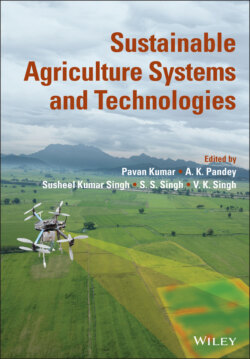Читать книгу Sustainable Agriculture Systems and Technologies - Группа авторов - Страница 44
3.1 Introduction
ОглавлениеSmall holder dairy animals thrive on crop by‐products and residues with open grazing in field. Very little concentrate mixture is generally fed to the animals, which are often unbalanced based on the availability with the farmers at home. Analysis of nutritional status of animals before ration balancing revealed that 89.4 and 60.9% animals were overfed in terms of TDN and crude protein (CP), respectively and 45.8 and 76% of the animals were underfed in terms of Ca and P, respectively in Gujarat (Garg et al. 2009). In Bihar, Dey and Kaushal (2006) observed 10–27% gap in DCP intake and 5–10% gap in TDN intake in lactating animals. Traditionally in India, forage and concentrate are fed separately to the dairy animals, which sometime results in higher risk of ruminal acidosis particularly in high yielders due to improper nutrients supply and thereby low reproductive and productive performance (Maekawa et al. 2002; Gupta et al. 2016). However, in many parts of India, particularly in wheat growing areas of northern India, in contrary to this, total mixed ration (TMR) feeding is a way to improve rumen conditions by supplying balanced nutrients at a time in the rumen which are essential for better utilization of nutrients (Bargo et al. 2003). It has been reported that supplementation of energy and protein in the diet improves average daily gain (ADG) in Holstein heifers and reduces rearing costs (Zanton and Heinrichs 2007). But at the same time, majority of the farmers in eastern India follow resource‐based separate feeding of roughages and concentrates (Gupta et al. 2014a). Following scientific feeding and management practices, feed conversion efficiency and profitability could be increased and green house gases (GHGs) emission could be reduced (Makkar 2016). For production of 1 kg milk or meat, GHG emission can be reduced by 25% by 10% improvement in digestibility. However, the sustainability of precession feeding is questionable due to poor infrastructure and maintenance support in developing countries (Makkar 2016). TMR (sani feeding system) and preparation of homemade balanced concentrate feed are two low cost technologies that can be widely disseminated in India. Ration balancing programme has extensively been applied by NDDB in different states of India (Garg et al. 2009; Garg and Bhanderi 2011). Recently few workers have observed positive effect in sani feeding system. Somvanshi et al. (2017) observed improvement in milk production by 15.78% following sani feeding technique with supplementation of mineral mixture as compared to farmer practice i.e. roughages without minerals. However, Gupta et al. (2014b) reported that inclusion of concentrate feed to the TMR @1.5% body weight was beneficial in crossbred heifers in respect of body weight gain and nutrients digestibility as compared to concentrate mixture @1% of body weight.
Keeping in view, the positive effect on milk production and wider scope of applicability among smallholders, TMR and homemade balanced concentrate feed were evaluated through, two trials to assess their impact of feeding on milk yield, intake of nutrients, and cost of milk production in crossbred dairy animals.
